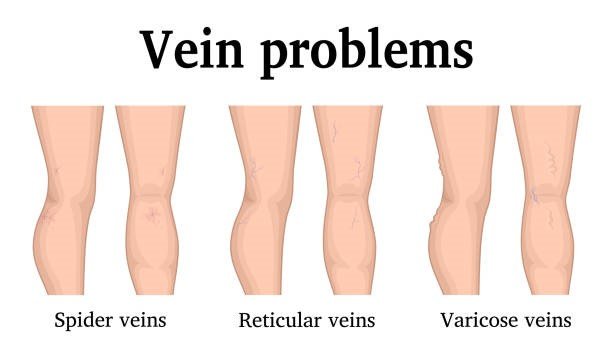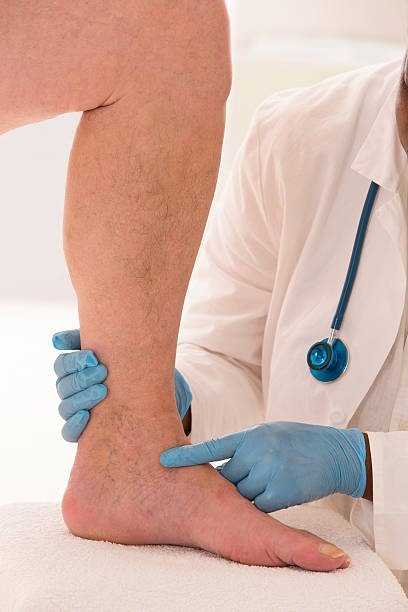What are Varicose Veins?
Varicose veins are abnormal dilated blood vessels in the skin that are commonly found in the legs. Varicose veins are veins that have a thickened or enlarged appearance. Varicose veins can occur in people of all ages, and they are most likely to occur in the legs and ankles. They can also occur in the hands, although this is not common. Varicoceles are varicose veins that form in the scrotum, and it is generally not a serious condition.
What are Spider Veins?
Spider veins (or spider nevi) are small, blue-purple veins that occur in the skin of the lower legs and around the ankle. Spider veins may be visible to the naked eye, but sometimes they can only be seen with certain types of light.

Differences between Varicose and Spider Veins
There are two types of veins that are commonly found in the body, the superficial and deep veins. The superficial veins – which are the ones that show up on the surface of your skin – are the result of the oxygen rich blood returning to your heart, while the deep veins are the ones that return the deoxygenated blood to your lungs. Vascular doctors refer to the superficial veins as “varicose” veins, while the deep veins are referred to as “spider” veins.
What causes Varicose and Spider Veins?
Varicose veins are common, and people with them often ignore them. They are dilated blood vessels that fill with blood when they become too long and may even cause pain and discomfort. Varicose veins may result from repeated pregnancy, heavy lifting, obesity, hormonal changes, and age. They are caused by the accumulation of extra blood in the veins, which is caused by the valves in the veins being damaged by the blood that is being stored in the veins.
Spider Veins are a common condition that occur on the lower extremities, such as the legs or feet. If you have been diagnosed with spider veins, there are several factors that may cause spider veins. The most common is genetics, as spider veins are very common among people with the Hereditary Angioedema (HAE) gene. Most of us have experienced some type of spider vein on our legs at some point in our lives. Veins are caused by an excess of the protein fibrin, which is derived from platelets in the blood. These platelets form a network known as the thrombus, which joins the underlying vein.
How are Varicose and Spider Veins diagnosed?
Varicose vein disease can cause symptoms and pain in the legs, and in some cases it can be difficult to diagnose. The pain of varicose veins can be constant or intermittent, and it can be felt in the back of the knee, in the thigh, or in the calf. Some people never notice any symptoms, while others are constantly in pain, and some people have varicose veins in both legs. The pain that occurs with varicose veins can be very intense and can be distressing.
Spider veins are tiny, shallow dilated blood vessels that are located in the flat areas of the skin, especially in the lower legs . If you have spider veins, you may have them in a single spot or in a group that runs across your lower legs. Often they can be found in the insides of your ankles.
About 20% of people over the age of 40 have spider veins, which can make the veins on the legs and below the knee look like a web. These are superficial veins that are visible only when a person’s leg is raised, for example, during a physical exam or during a blood test. If left untreated, spider veins can grow and become varicose veins or cellulitis. These types of veins can cause pain, numbness, and other symptoms. While spider veins are not dangerous, they can be unsightly and are associated with a higher risk of age-related skin conditions, such as skin cancer. They are most common in women, who experience them most often during their reproductive years, but their prevalence is not limited to any particular age group.

How are Varicose and Spider Veins treated?
Varicose veins are problems affecting your veins which can cause pain and discomfort and also cause certain unwanted side effects. Varicose veins can either appear in your legs or other parts of your body. You can get varicose veins as a result of aging and pregnancy. There are a number of treatment options available such as sclerotherapy, sclerotherapy plus laser therapy.
The spider veins of our bodies are very important, since they carry blood to every organ in the body. When they become weak, they are prone to infections and clogged by fatty tissue and bacteria. The best treatment is to use lasers to safely kill the bacteria and heal the veins. In some cases, the affected veins can be treated with injections of special chemicals.





